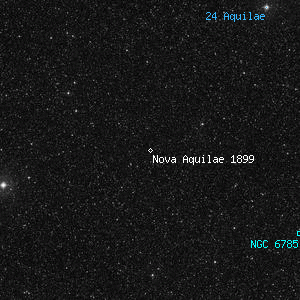Nova Aquilae 1899

Overlaid DSS image of Nova Aquilae 1899, 60' x 60' with north at top and west to the right
Aladin viewer for the region around Nova Aquilae 1899
Nova Aql 1899, V606 Aql, IC 4850
| Type | Nova |
|---|---|
| Magnitude | 20.41 | Right Ascension | 19h 20' 24.2" (2000) |
| Declination | 0° 8' 8" S |
| Constellation | Aquila |
Observing Notes
Harold Corwin
IC 4850 = Nova Aql 1899 = V606 Aql. Dreyer included this nova because Fleming and Pickering noted the emission lines of a gaseous nebula in its spectrum. The Harvard Circular (No. 56) gives the position to only an arcminute, but Pickering published a more precise -- and presumeably more accurate -- position in his earlier note in ApJ 12, 52, 1900. That position lands close to a small triangle of three stars with a fourth a few arcseconds to the southwest. The finding chart given by Duerbeck in his 1987 catalogue and atlas of Galactic novae labels three stars as candidates; Duerbeck notes "The exnova is a blend of three stars ..." (note that his position for star "3" actually applies to the fourth star that I noted just above).
My initial search of the literature turned up nothing more definitive in the way of an identification. However, Ringwald, Naylor, and Mukai (MNRAS 281, 192, 1996) have a note that a spectrum of star 2 shows it to be a typical G7-K4 star, making it unlikely to be the nova.
So, I cannot give a positive identification for this IC object at the moment (October 2015). However, it is possibly either of stars "1" or "3"; positions for all four of these are given in the table.
Digging further into the literature early in September 2016, I was able to find a reference in Downes, Webbink, and Shara (PASP 109, 345, 1997) to a 1900 measurement of IC 4850 by Bigourdan (in CR 131, 239, 1900). At the time, in July of 1900, Bigourdan estimated the magnitude of the nova to be 12 to 12.5, and wrote that it showed no trace of enveloping nebulosity. He has two measurements of the nova on 18 and 20 July, both with respect to BD -0 3710. In 1900, there was no accurate position known for this BD star, but the nearby BD -0 3705 did have a good position in the "Copenhagen and Borgen" catalogue. So, Bigourdan also has measured an offset from that star to his direct comparison star. This allowed him to give an accurate position for the nova.
Now we have several accurate positions available for BD -0 3710 itself. I've used that in URAT1 with the accompanying proper motions calculated using the 2MASS PSC position. Bigourdan's two-step position for the nova precessed directly from his note, is just 2.6 arcseconds off the position calculated using the modern data. Both positions (or a mean value if you prefer) strongly suggest that "star 3" in the position table is the nova. Correcting my own position estimate with SkyView on the DSS2 blue plate for that star with respect to stars 1, 2, and 4 (by +0.02 seconds and -0.6 arcseconds), Bigourdan's position is just 1.6 arcseconds from the SkyView position. Spectroscopic confirmation would be good to have.
It's also possible, of course, that the actual nova is below the plate limit of the DSS2 images. The red plate seems to suggest, too, that there is another even fainter star just northeast of star 3. Could this be the nova? Gaia DR1 astrometry has resolved these two sources, so I've called the fainter of them "I4850 star 5".
Brian Skiff has found a recent paper by Tappert et al. (MNRAS, 462, 1371, 2016; the preprint is available at https://arxiv.org/abs/1608.00527) on recovery of old novae, including V606 Aql. They have used the 8-m Antu telescope at Cerro Paranal for photometry, and the Gemini-South 8-m telescope at Cerro Panchon for spectroscopy to show that "star 3" is indeed the post-nova, and they publish a finding chart as well. The star's color indices (B-V = 0.40, U-B = -0.28, V-R = 0.44) are typical of a moderately reddened post-nova, and the spectrum shows emission lines of hydrogen and helium, also typical of post-novae. The V magnitude is 20.41 +- 0.03.
So, IC 4850 is finally unabiguously identified. I have updated the position table with positions from Gaia DR2 to reflect this.
Other Data Sources for Nova Aquilae 1899
Nearby objects for Nova Aquilae 1899
4 objects found within 60'
| 24 Aquilae | d Aquilae | |
| NGC 6785 |
Credits...
Drawings, descriptions, and CCD photos are copyright Andrew Cooper unless otherwise noted, no usage without permission.
A complete list of credits and sources can be found on the about page
Nova Aquilae 1899